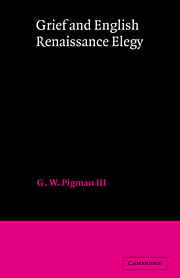Book contents
- Frontmatter
- Contents
- Acknowledgments
- Introduction
- Chapter 1 The Angry Consoler
- Chapter 2 The Emergence of Compassionate Moderation
- Chapter 3 Praise and Mourning
- Chapter 4 The Shift from Anxious Elegy
- Chapter 5 Surrey and Spenser
- Chapter 6 Jonson and King
- Chapter 7 Milton
- Conclusion
- Notes
- Bibliography
- Index
Chapter 3 - Praise and Mourning
Published online by Cambridge University Press: 28 August 2009
- Frontmatter
- Contents
- Acknowledgments
- Introduction
- Chapter 1 The Angry Consoler
- Chapter 2 The Emergence of Compassionate Moderation
- Chapter 3 Praise and Mourning
- Chapter 4 The Shift from Anxious Elegy
- Chapter 5 Surrey and Spenser
- Chapter 6 Jonson and King
- Chapter 7 Milton
- Conclusion
- Notes
- Bibliography
- Index
Summary
Funeral elegies represent various aspects of the process of mourning. Obvious as this declaration may seem, it is not generally accepted. Most scholars agree that the major purpose of Renaissance elegy, both in theory and in practice, is to praise the deceased, and that lament and consolation, the other components of elegy, are of secondary importance and often no more than indirect forms of praise. There are two reasons why this view prevails. First, most elegies praise the deceased, and many are little more than excuses for encomium. Second, both classical and Renaissance writers classify funeral orations and elegies as branches of epideictic rhetoric, the traditional functions of which are praise and blame. In this chapter I shall argue that classification of elegy as epideictic does not imply that praise is its primary function and that it is more comprehensive to conceive of elegy as a representation of the process of mourning.
Since O. B. Hardison, Jr., is the most influential interpreter of elegy as the poetry of praise, I shall begin by citing his argument for this position.
The fact that the funeral elegy was always considered an epideictic type has already been mentioned. This resolves the problem by making it clear that praise is the essential element of the form.
- Type
- Chapter
- Information
- Grief and English Renaissance Elegy , pp. 40 - 51Publisher: Cambridge University PressPrint publication year: 1985



